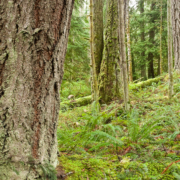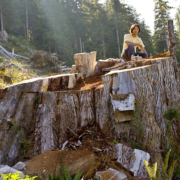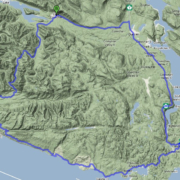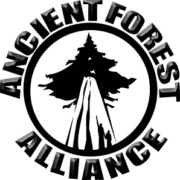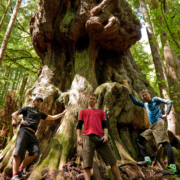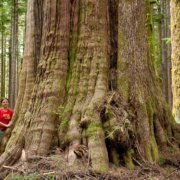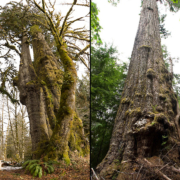The following is an excellent article from March in UBC’s student newspaper, The Ubyssey. Note the comment from the president of the Truck Loggers Association in favour cutting down Cathedral Grove as the old-growth is “decaying” and “falling over” and creating a park in younger forests somewhere else! Old school 1980’s thinking, long since marginalized by insights from the science of forest ecology.
– Ken Wu, Ancient Forest Alliance
Canada is among the last of the developed nations that logs its old-growth forests. In the US, the vast majority of logging takes place in second-growth stands, while Europeans log second- and third-growth forests. Southwestern Australia halted the logging of its old-growth forests six years ago, as did New Zealand in the year 2000.
Enter the Ancient Forest Alliance (AFA), a recently launched lobby group that works to change this.
The Handcuffs Come Off
The AFA advocates for the protection of old growth forests and ban raw log exports. They held their launch event this January in front of Greater Victoria’s largest douglas fir, where they outlined their approach to environmental advocacy.
Unlike similar organizations, the AFA announced that they will not seek charitable status. This hurts the group’s ability to fundraise, but relieves them of what co-founder Ken Wu calls “the handcuffs of charitable status.”
Organizations with charitable status cannot support or oppose any political candidate running for public office. Charities are also limited by what is called the “ten per cent rule”: only ten per cent of the charity’s resources can be spent explicitly calling for law or policy changes. Without these limitations the AFA can exert as much of their resources as they see fit to call for governmental policy changes.
The AFA will also be able to publish which politicians support policies to protect old-growth forests, and which politicians maintain that old-growth forests in BC are not endangered. The handcuffs are off and the gloves are on.
The AFA wants the BC Liberals to pursue policies that protect remaining old-growth stands. Wu maintains that BC’s policies surrounding company rights to log old-growth forests will have to change soon. He said that the supply of large and readily accessible old-growth trees in southern BC is almost exhausted.
The UBC Connection
Several of the core members of the AFA – Ken Wu, Tara Sawatsky and TJ Watt – previously worked for the Western Canada Wilderness Committee (WCWC), an organization that was instrumental in getting UBC’s Ancient Forest Committee (AFC) up and running.
Monika Dean, the current head of the UBC AFC, said the WCWC helped them create strategies to inform the public about the urgency to protect old-growth trees and train AFC members for campaigning. They also helped fund trips to Tofino so that students could see first-hand the wilderness that the UBC AFC wants to protect.
It’s a high priority for the UBC AFC to keep them going on the Tofino trips, but they are expensive. Students not only get to see what an old-growth forest looks like, but also learn about how to run a political campaign and talk to the media.
The AFA intends to do much its lobbying very near UBC at the Vancouver-Point Grey, which is also Premier Gordon Campbell’s riding. “The AFA plans to work very closely with the students and community old-growth protection groups – including the UBC and Point Grey Ancient Forest Committees. We also want to start new [Ancient Forest Committees] on other campuses and swing ridings,” said Wu.
Logging, Old-Growth and Clear-Cutting
The AFA has formulated several specific calls for the BC Liberal government. Their first call is not at all that surprising given their name – they’re calling for the immediate protection of at risk old-growth forests. Their second call is for the BC Liberal government to ensure a sustainable rate of second growth logging.
When asked if the AFA had formulated a concrete definition for ‘sustainable rate of cut,’ Ken Wu says:
“A sustainable rate of cut involves reduced rate of cut. You slow down. It means that you’re not going to run out of mature trees and be left with young trees that are not ready to harvest. It means a longer rotation of 200 or 400 years in coastal forests. It would mean a loss of conventional clear-cutting jobs, but it doesn’t necessarily mean a loss of jobs in the logging industry. We advocate more labour-intensive selective logging combined with value added manufacturing.”
They will face some opponents. “Clear cutting is done for a reason,” says Wayne Lintott of the Interior Logging Association, who claims that clear-cutting is not solely a profit-driven practice. He gives clear-cutting the interior of BC as an example because like in Hope by Manning Park, the mountain pine beetle is devastating wood crops. The trees which he was referring to are second growth trees. Lintott likened the logging industry to farming. “We can replant. It regrows. It’s a sustainable industry.”
Dave Lewis of the Truck Loggers Association challenges the unthinking use of the word “old-growth.” The definition of “a previously untouched tree,” is an unrealistic one, he explains given the First Nations’ use of trees and the forest-thinning effects of large fires.
“The forest typically referred to as ‘old-growth’ are 600 to 700 years old and are at the end of their lives,” he said. “They have decaying and falling over trees. Naturally these forests typically revert from large Douglas first to a hemlock and cedar mix.”
“The way to regenerate the douglas first that people so prize is for there to be a burn – but burns are unsafe and not publicly tolerated. Harvesting mimics the effect of the burn.”
According to Lewis, old Douglas first typically regenerate in full sunlight and in mineral soil, which are the typical conditions to be found after a large forest fire.
Lewis believes that a longer rotation period could be good. He says a longer rotation time, particularly for trees in isolated locations such as cliff faces, make logging more economical, because the lumber per square meter becomes more valuable. Also, more land is protected in reserves than is available for harvesting this way. Lewis feels that it is in everyone’s best interests – environmental activists and logging interests alike – to work together.
“We need to identify a reasonable amount of forest types in specific areas that we want to preserve and how we can best manage that,” he says. “Imagine if we started to actively manage our parks. If people are saying that ‘we love old douglas firs’ – how cool would it be if when a park [like Cathedral Grove] turns 400 years old and starts to decay we could replace it with a 200 year old park [in the same area with the same types of trees] and let that park grow for 200 years.”
Beyond Logging
How trees are logged isn’t the only issue. The AFA is also concerned about BC’s policies regarding raw log exports. They would like to see the BC Liberals shift the focus of the logging industry away from raw log exports and towards BC-based milling and value-added manufacturing.
To this end, the AFA wants the BC Liberal government to halt the export of raw logs to countries like the USA and Japan in order to promote log supplies for BC industries. Moreover, the AFA wants to see the BC Liberals assist in the re-tooling of local mills to handle second-growth logs rather than old-growth logs, and the building of value-added wood processing facilities in BC.
Finally, the AFA wants the provincial government to undertake new land-use planning initiatives based on First Nations land-use plans, scientific assessments and climate mitigation strategies. Wu believes that “old-growth forests should be an important part of BC’s climate change mitigation strategy because old-growth forests can store as much as two to three times more carbon per hectare than second-growth forests.”
“Our goals are doable,” Ken Wu says confidently. “We’re following a strategy that works. We’re continually building grassroots support and education the public. An educated public exerts the greatest lobby pressure on government.”
The AFA will be in the neighbourhood very soon. On March 27, they’re holding an Avatar-themed protest at noon starting at Canada Place. There will be speeches to follow in front of the Vancouver Art Gallery at 1pm.
It’s going to be a busy week for environmental protestors, as the UBC AFC is also having a protest on Friday, March 26, on campus. They will be doing an “aerial art piece” where protesters will arrange themselves at noon in front of Koerner’s Library in a configuration to be photographed form above. In the past, UBC AFC members arranged themselves into the shape of a pine tree.


